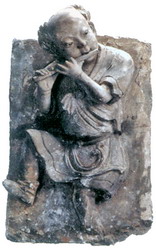In the Northern Song Dynasty, sanyue, a form of performance incorporating folk songs, gymnastics, dance and zaxi, was synonymous to baixi (literally “a hundred shows”). In fact, baixi was one of the thirteen types of sanyue performances. As studies on these carved bricks have shown, sanyue performance was very popular and prevalent in the Northern Song Dynasty. The figures portrayed also shed light on the major types of sanyue instruments in Bianliang (now Kaifeng), capital of the Northern Song Dynasty, and its surrounding areas. This type of sanyue performance was actually the embryonic form of Chinese opera.
Sanyue in the Song Dynasty inherited the momentum of development of sanyue in the Sui and Tang Dynasties and became a general name for a specific type of performing arts.
In the early Northern Song Dynasty, the royal court established the largest musical institution ever, known as jiaofang. In its early years, jiaofang had kept the Tang system. Later, it was divided into 13 branches by the different types of musical instruments. In 1144 (the early years of Jianyan period during the reign of Emperor Gaozong of Song), the old system was restored, the musical instruments and the ways of their composition were improved. This laid the foundation for subtly expressive Chinese string music.
In the early years of the Song Dynasty, sanyue was often alternated with zaju (stage plays). Of all the musical instruments employed, the clapper and jiegu drum (“waisted drum”) were the most important. After sanyue and zaxi came in contact with the Song court and upper classes, they were rejected by music administrators and history-keeping officials who participated in the civil administration. In Dasheng Prefecture in 1113 (3rd year of Zhenghe period), a decree was issued to ban “vulgar and morally loose music” such as “daduan (a type of drum-and-clapper music), shaodi (zufolo-like instrument), yagu (a type of drum music), shibanwu (literally ‘ten types of dance’), and xiaoguqiang (literally ‘small-drum singing’)”[2]. This historical record reveals the function of sanyue in ridiculing and satirising, which became the predominant feature of sanyue performance in the Song Dynasty. It can thus be seen that, in the Song Dynasty, the ritual music of the court was played along with popular folk music, thereby forming a unique feature of sanyue and zaju: “music alternated with stage play”.
Now we’d like to introduce some Song and Jin carved bricks of different styles which represent sanyue musicians.
In April 1982, a carved brick portraying sanyue musicians was unearthed from a Song tomb at Qiandongnanwang Village, Wenxian County, Henan Province[3]. 40.2cm high, 27.5cm wide and about 1cm thick, the brick portrays six men standing before a screen and facing the same direction. As portrayed, each of them wears a futou cloth hat with wing-like flaps. Each of the two men on the lower right carries a long drum horizontally at the waist. A zheng (traditional Chinese instrument zither) is placed on two cylindrical stands. The man on the left holds a sceptre with both hands. In the back row, the man on the left holds a bili, whereas the other on the right is beating fangxiang (chime stone-like percussion instrument) with a stick.
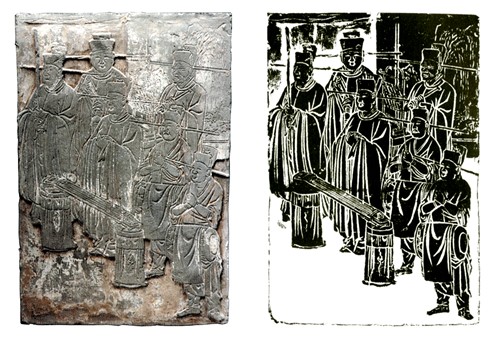
In 1973, five Song Dynasty carved bricks portraying sanyue musicians were unearthed at Jiecun Village, Xiaojie Township, Luoning County, Henan Province [4]. The first figure from the left is 38cm tall; in front of him, there is a jiegu drum placed on a tripod, and the drum and its stand measure 17cm in height in total. The right hand on the drum, the drummer raises the stick in his left hand, with the gesture of beating the drum and singing. The second figure from the left, 40cm tall, has a zhanggu drum tied in front of the belly and covered with a piece of cloth. As portrayed, he is beating the drum with his left arm raised. The 3rd figure from the left, 41cm tall, is whistling with his right hand placed at his mouth and the left hand holding a clapper. The 4th figure from the left, a 39cm-tall female musician who wears a chignon, is playing a flute held in both her hands. Her right shoulder is broken at the edge. The 5th figure from the right, 41cm tall, is playing a bili held in both hands.
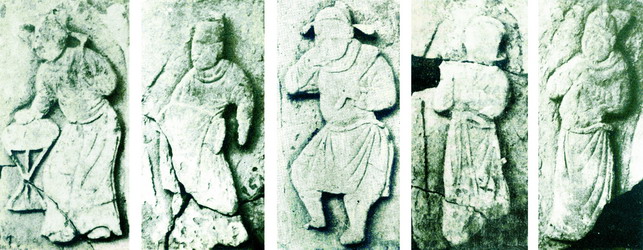
Some carved bricks representing musicians were also unearthed in Bota Pagoda, Kaifeng City, Henan Province. Each of the bricks has a round recess 21.5cm in diameter, where the musicians are carved. The musician on the upper left plays a bili, and the one on the upper right holds a flute in both hands. The musician on the middle left plays a crooked-neck pipa; and the one on the middle right beats a waist drum placed on his legs with his left hand and holds a stick in his right hand. The musician on the lower left beats a drum, and the one on the lower right holds a six-piece paiban (percussion instrument) in both hands.
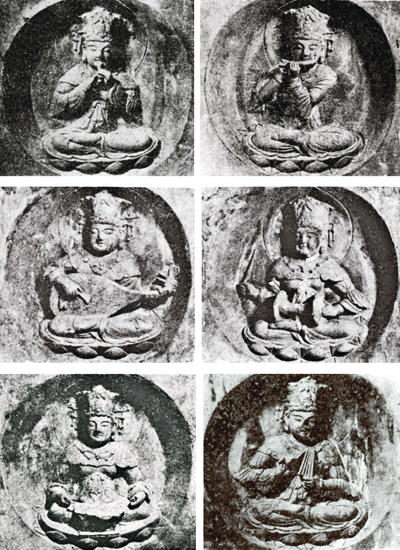
Carved bricks representing musicians unearthed in Fanta Pagoda, Kaifeng City, Henan Province
In 1973, a set of carved bricks portraying adolescent sanyue musicians was unearthed from a Jin tomb at Xifengfeng Village, Jiaozuo City, Henan Province [6]. The young musician on the left, 35.5cm tall, is a drummer; the one in the middle, 35cm tall, a flute blower; and the one on the right, 39cm tall, is a clapper player.
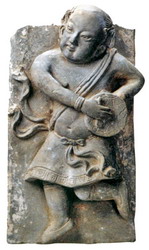
|
|
|
Adolescent sanyue musicians portrayed by the carved bricks unearthed in Jiaozuo City, Henan Province
The above carved bricks representing sanyue musicians shed light on the form of ritual musical performance in the Northern Song royal court and the two forms of performance invented by jiaofang in the early Song Dynasty—“dance-ensemble of female performers” and “dance-ensemble of children”[8], and on large-scale temple bands in the Northern Song Dynasty [7].
Dear readers, can you figure out the different roles of the musicians portrayed on the carved bricks in the collection of Henan Museum according to their different hats?
Your answer please, if you have any questions or answer, please feel free to send us email, we are waiting for your answers and participation, and your comments, answers and suggestions will be highly appreciated. We will select and publicize the most appropriate answers and comments some time in the future.
Weekly Selection Email: meizhouyipin@chnmus.net
Paiban and Jiegu—Two Sanyue Instruments in the Northern Song Dynasty
[9]The paiban used by the jiaofang in the Northern Song Dynasty consists of six pieces made of sandalwood or mulberry wood. With a thin and sharp upper part and a round and thick lower part, they are joined together by leather strips. [10] The jiegu drum of the Song Dynasty has a stand. There were records on the use of the paiban and jiegu in each of the four sections of music in the Song Dynasty, especially on the paiban.
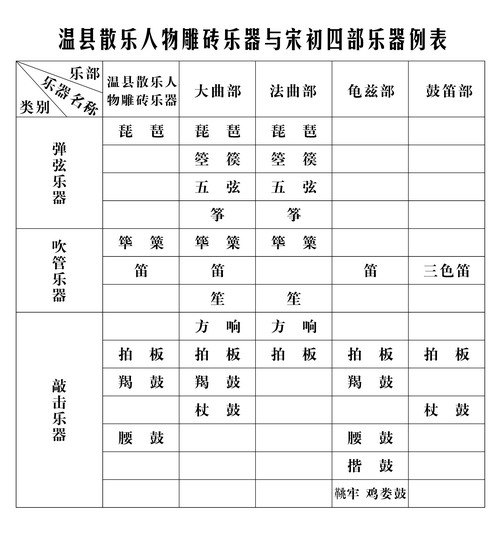
Notes:
[1] LUO Huojin, WANG Zaijian. Song Tomb in Xiguan, Wenxian County, Henan Province. Chinese Archaeology, 1996(1).
[2] p.3012, p.3017. Vol.129, “On Music”, History of Song
[3] ZHAO Weimin, HUANG Yanru. A Study of Song-dynasty Musician Represented on Carved Bricks in Fanta Pagoda, Kaifeng City. Journal of Henan University, 1988(4).
[4] LI Xianqi, WANG Xingqi. A Tentative Study of Song-dynasty Carved Bricks Representing Zaju Figures in Luoning County. Central Plains Archaeology, 1988(4).
[5] HAN Shunfa. An Investigation of Musical Instruments in Fanta Pagoda. Central Plains Archaeology, 1990(4).
[6] Henan Museum, Jiaozuo Municipal Museum. A Brief Report on Excavation of Jin Tomb in Jiaozuo City, Henan Province. Archaeology, 1979(8).
[7] Luoyang Municipal Cultural Heritage Work Team. A Brief Report on Excavation of Song Tomb with Brick Carvings at Guanlin Temple, Luolong District, Luoyang City. Archaeology, 2011(8),
[8] P.24, Vol.24, “The Tenth Lunar Month of the Ninth Year of Taiping Xingguo Period”, Sequel to Comprehensive Mirror to Aid in Government.
[9] P.139, Vol.139, General Investigation on Important Writings.
[10] P.136, Vol.136, General Investigation on Important Writings.
In April 1991, when a brick factory on Xiguansanjie Street, Wenxian County, Henan Province, dug the ground for earth, they discovered a brick tomb chamber imitating wooden construction and dating from the Northern Song Dynasty. This set of carved bricks representing musicians was found in a row on the northeast wall of the tomb chamber. The figures were originally coated with white paint, most of which has peeled off at present.[1]
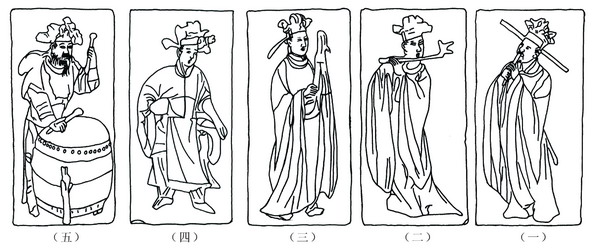
The first figure from the right: The first figure from the right wears a futou cloth hat with a decorated top and two wing-like flaps, an underdress featuring a crossover collar, a ground-sweeping long robe with a U-shaped collar and broad sleeves, and a belt around the waist. With his body tilting to the left slightly, his head up a bit, and both his arms raised, the musician holds a bili (Chinese musical instrument) with both his hands and places it at the mouth with playing gesture. This figure is the bili blower in the traditional Chinese sanyue band.
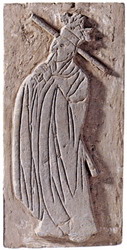 |
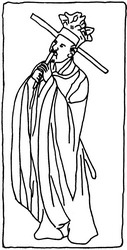
|
The first carved brick from the right and facsimile of the carved image
The second figure from the right: Eyes to the lower left, the second figure from the right wears a flapless futou cloth hat with a decorated top and a fan-shaped brim, a round-collared long robe with broad sleeves which, like the robe bottom, stretch to the ground. With his body tilting to the left slightly and both his arms raised to the right side, the musician, flute blower in the traditional Chinese sanyue band, is portrayed as playing a long flute with dragon-head design.
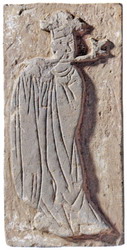
|
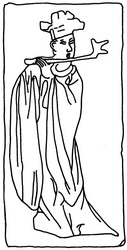
|
The second carved brick from the right and facsimile of the carved image
The third figure from the right: The third figure from the right wears a cloth hat with two wing-like soft flaps, a high-collared underdress, and a ground-sweeping round-collared long robe with broad sleeves, which reveals the front parts of the feet. Tilting to the right slightly, the musician, pipa player in the traditional Chinese sanyue band, stands and holds a pipa (Chinese stringed instrument) in front of his left chest and plays it with his right hand.
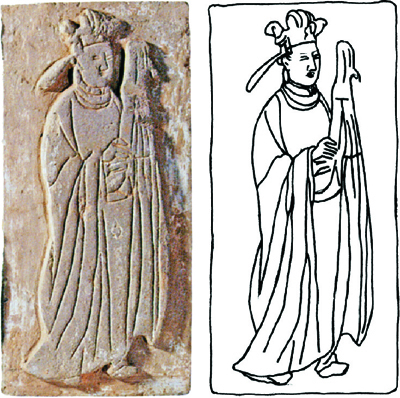
The fourth figure from the right: The fourth figure from the right wears a futou cloth hat with a flower-shaped “high-hairpin” (gaozan) ornament and two wing-like round-ended flaps, an underdress featuring a crossover collar, a round-collared robe that stays open at the front and has narrow sleeves and a hem stretching below the knees, and a pair of trousers with leggings. From the waistband hangs a waist drum under the long robe. Tilting to the left slightly, eyes to the lower left, and straddling, the musician, waist drummer in the traditional Chinese sanyue band, beats the drum with his hands while singing.
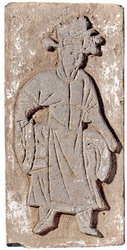
|
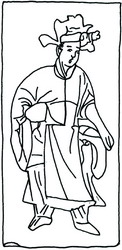
|
The fourth carved brick from the right and facsimile of the carved image
The fifth figure from the right: The fifth figure from the right wears a futou cloth hat with a top resembling an outstretched flower, a round-collared long robe with narrow sleeves, and a waistband. With his lively-looking whiskered face turned slightly to the left and his eyes wide open, the musician raises the drumstick in his left hand above his left shoulder and strikes the jiegu drum, with a stand beneath, forcefully with the other drumstick in his right. This figure is the drummer in the traditional Chinese sanyue band.
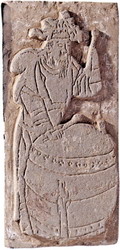
|
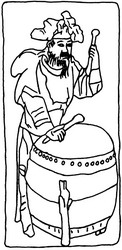
|
The fifth carved brick from the right and facsimile of the carved image
This set of carved bricks in the collection of Henan Museum represents in bas relief different-looking musicians playing five different types of musical instruments including the bili, flute, pipa, zhanggu drum, and drum in the Song Dynasty sanyue band. It sheds light on the prospering sanyue industry of the Central Plains in Henan Province during the Northern Song Dynasty. With the musicians simply yet vividly represented, the five carved bricks, well preserved, can be regarded as rare artworks. They provide material evidence for studies on Chinese music & opera, culture & art in the Song Dynasty.
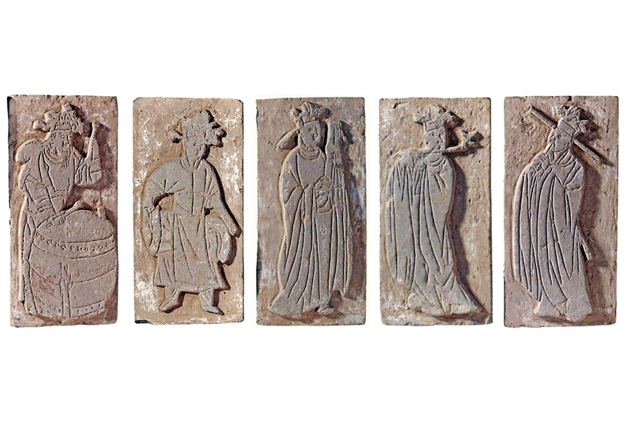

Zhao Le: a museologist of the Collections Administration Department of Henan Museum, dedicated to collections design and research.
